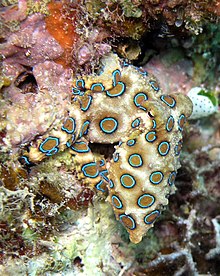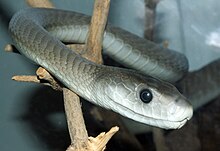
Numerous animal species naturally produce chemical toxins which are used to kill or incapacitate prey or as a defense against predators. Venomous animals actively deliver their toxins (called venom) into their target through a specially designed mechanism, such as a bite or sting, by using a venom apparatus, such as fangs or a stinger, in a processes called envenomation.[1][2] They are often distinguished from poisonous animals, which instead passively deliver their toxins (called poison) to their victims upon contact such as through inhalation, absorption through the skin, or after being ingested.[1][2][3] The only difference between venomous animals and poisonous animals is how they deliver the toxins.[3] This list deals exclusively with venomous animals.
Venoms have adapted to serve a wide variety of purposes. Their intended effects can range from mild fleeting discomfort to paralysis and death, and they may be highly selective in which species they target, often making them harmless to all but a few specific organisms; what may be fatal to one species may be totally insignificant to another species. Because the definition of "venomous" can be extremely broad, this list includes only those animals with venom that is known or suspected to be medically significant for humans or domestic animals.
Invertebrates[edit]
Arthropods[edit]
Arachnids[edit]
Strictly speaking, all spiders and scorpions possess venom, though only a handful are dangerous to humans. Spiders typically deliver their venom with a bite from piercing, fang-like chelicerae; scorpions sting their victims with a long, curved stinger mounted on the telson.
Spiders[edit]

- Australian funnel-web spiders[4] (Atrax and Hadronyche spp.)
- Brazilian wandering spiders (Phoneutria spp.)
- All widow spiders (Latrodectus spp.), including the black widows, button spiders, Australian redback spider (L. hasseltii), and the endangered katipō of New Zealand (L. katipo)
- False black widows (Steatoda spp.)
- All recluse spiders (Loxosceles spp.), including the brown recluse (L. reclusa) and Chilean recluse (L. laeta)[5]
- Macrothele spp.
- Mouse spiders (Missulena spp.)
- Sicarius spp.
- Hexophthalma spp.
- All species of tarantula (in addition to chelicerae, some also have urticating hairs)
Scorpions[edit]
Of more than a thousand known species of scorpion, only a few dozen have venom that is dangerous to humans,[6] most notably the bark scorpions, including:
- Centruroides spp.
- Deathstalker (Leiurus quinquestriatus)
- Central and South American Tityus, include the Brazilian yellow scorpion.
- Androctonus spp.
- Parabuthus spp.
- Hottentotta spp.
Insects[edit]
- Bees and wasps (see Bee sting)
- Some ants (see Ants of medical importance)
- Certain lepidopteran caterpillars are covered in urticating hairs for defense
Other arthropods[edit]
- Many species of centipede
- The remipede Xibalbanus tulumensis is a centipede-like crustacean that lives in underground anchialine caves of Mexico and Central America. Although blind, it is a formidable predator and feeds on the shrimp that share its underground pools.[7]
Mollusks[edit]
- Cone snails of the family Conidae are a diverse group of predatory marine gastropods, mostly tropical in distribution, which hunt and immobilize prey using a modified harpoon-like radular tooth that can deliver neurotoxic conopeptides. All cone snails are venomous, though the danger posed to humans varies widely by species.
Many species of octopus, squid, and cuttlefish make use of venom when hunting their prey.
- The blue-ringed octopodes (Hapalochlaena spp.) produce tetrodotoxin, which is extremely toxic to even the healthiest adult humans, though the number of actual fatalities they have caused is far lower than the number caused by spiders and snakes, with which human contact is more common.[8]
Cnidarians[edit]
- Jellyfish sting using microscopic cells called nematocysts, which are capsules full of venom expelled through a microscopic lance. Contact with a jellyfish tentacle can trigger millions of nematocysts to pierce the skin and inject venom.[9]
- Some hydrozoans, including the Portuguese Man o' War (Physalia physalis)
- Some sea anemones
- Some corals
Echinoderms[edit]
- Several species of sea urchins are venomous. The toxins are injected through their spines or pedicellariae.[10]
Chaetognathans[edit]
- Chaetognathans, known as arrow worms, use the grasping spines in front of their mouth to catch prey and inject them with tetrodotoxin produced by symbiotic bacteria.[11][12]
Annelids[edit]
Glyceridae, also called bloodworms, is a family of carnivorous polychaete worms which have an eversible proboscis equipped with four jaws connected to venom glands, used for killing the invertebrates they feed on.[13]
Vertebrates[edit]
Fish[edit]

There are at least 1,200 species of venomous fish, including:
- Stonefishes (Synanceia spp.)
- Lionfishes (Pterois spp.)
- Scorpionfishes
- Toadfishes (Daector and Thalassophryne spp.)[14]
- Rabbitfishes (Siganus spp.)
- Goblinfishes (Glyptauchen panduratus and Inimicus spp.)
- Cockatoo waspfish (Ablabys taenianotus)
- Striped blenny (Meiacanthus grammistes)
- Stargazers
- Chimaeras
- Weevers (Echiichthys vipera and Trachinus spp.)
- Dogfish sharks
- Most stingrays[15]
- most catfish species have venomous "stings" behind their fins, including:
- The estuary cobbler (Cnidoglanis macrocephalus)
- The striped eel catfish (Plotosus lineatus) and other eeltail catfishes (Neosilurus spp.)
- The Asian Stinging Catfish (Heteropneustes fossilis)
Reptiles[edit]
Snakes[edit]

- Nearly all elapids, for example
- Australian black snakes (Pseudechis)
- All true cobras (Naja spp.), including the Indian cobra (Naja naja)
- King cobra (Ophiophagus hannah)
- Coral snakes (Micrurus, Leptomicrurus, and Micruroides spp.)
- Belcher's sea snake (Hydrophis belcheri)
- Dubois' sea snake (Aipysurus duboisii)
- Brown snakes (Pseudonaja), including the eastern brown snake (Pseudonaja textilis)
- Death adders (Acanthophis spp.)
- Kraits (Bungarus spp.), including the common krait (Bungarus caeruleus)
- Mambas (Dendroaspis spp.), including the black mamba (D. polylepis)
- Taipans (Oxyuranus)
- Tiger snakes (Notechis spp.)
- Vipers, for example
- Bushmasters (Lachesis spp.)
- Copperhead (Agkistrodon contortrix) and cottonmouth (Agkistrodon piscivorus)
- Lanceheads (Bothrops spp.), including the fer-de-lance (B. lanceolatus) and the terciopelo (B. asper)
- Rattlesnakes (Crotalus and Sistrurus spp.)
- Russell's viper (Daboia russelii)
- Saw-scaled viper (Echis carinatus)
- Boomslang (Dispholidus typus)
Lizards[edit]
- Gila monster (Heloderma suspectum)
- Mexican beaded lizard (Heloderma horridum)
- Some members of the genus Varanus, such as the Komodo dragon (V. komodoensis), perentie (V. giganteus), and lace monitor (V. varius)
Dinosaurs[edit]
Some scientists have proposed that Sinornithosaurus had a venomous bite, but recent evidence suggests otherwise.[16]
Amphibians[edit]
Though there are numerous poisonous amphibian species capable of secreting lethal toxins through their skin, relatively few amphibians are truly venomous.
Frogs[edit]
- Bruno's casque-headed frog (Aparasphenodon brunoi)
- Greening's frog (Corythomantis greeningi)
Salamanders[edit]
- Fire salamander (Salamandra salamandra)
- Iberian ribbed newt (Pleurodeles waltl)
Caecilians[edit]
Mammals[edit]
Only a few modern mammal species are capable of producing venom; they are likely the last living examples of what was once a more common trait among the mammals. The definition of "venomous" becomes less distinct here, however, and whether some species are truly venomous is still debated.
- European mole (Talpa europaea)
- Platypus (Ornithorhynchus anatinus)[a]
- Eurasian water shrew (Neomys fodiens)
- Mediterranean water shrew (Neomys anomalus)
- Northern short-tailed shrew (Blarina brevicauda)
- Southern short-tailed shrew (Blarina carolinensis)[disputed]
- Elliot's short-tailed shrew (Blarina hylophaga)[disputed]
- Both species of solenodon, the Cuban solenodon (Solenodon cubanus) and the Hispaniolan solenodon (S. paradoxus)
- Slow loris (Nycticebus spp.)[19] [20]
- Pygmy loris (Xanthonycticebus pygmaeus)[21]
See also[edit]
Notes[edit]
References[edit]
- ^ a b Gupta, Ramesh C. (24 March 2017). Reproductive and developmental toxicology. Saint Louis. pp. 963–972. ISBN 978-0-12-804240-3. OCLC 980850276.
{{cite book}}: CS1 maint: location missing publisher (link) - ^ a b Chippaux, JP; Goyffon, M (2006). "[Venomous and poisonous animals--I. Overview]". Médecine Tropicale (in French). 66 (3): 215–20. ISSN 0025-682X. PMID 16924809.
- ^ a b "Poison vs. Venom". Australian Academy of Science. 3 November 2017. Retrieved 17 April 2022.
- ^ Funnel-web Spiders Archived 27 June 2009 at the Wayback Machine at the Australian Museum, Sydney
- ^ Jone SC. "Ohio State University Fact Sheet: Brown Recluse Spider". Archived from the original on 16 July 2012. Retrieved 2 September 2006.
- ^ "Poisonous Animals: Scorpion (Scorpiones)". library.thinkquest.org. ThinkQuest. c. 2000. Archived from the original on 4 March 2009. Retrieved 16 December 2009.
- ^ "Meet the World's Only Known Venomous Crustacean". 8 January 2014.
- ^ Jacups, Susan & Currie, Bart. (2008). Blue-ringed octopuses: a brief review of their toxicology. Northern Territory Naturalist. 20. 50–57.
- ^ "Stinging Mechanism". Jellyfish Art. 16 August 2010. Archived from the original on 2 March 2012.
- ^ Recent Studies on the Pathological Effects of Purified Sea Urchin Toxins
- ^ Biology of meso- and bathypelagic chaetognaths in the Southern Ocean
- ^ Tetrodotoxin-Producing Bacteria: Detection, Distribution and Migration of the Toxin in Aquatic Systems
- ^ A Polychaete’s Powerful Punch: Venom Gland Transcriptomics of Glycera Reveals a Complex Cocktail of Toxin Homologs
- ^ Grady, Denise Venom Runs Thick in Fish Families, Researchers Learn The New York Times 22 August 2006.
- ^ Ternay, A. "Dangerous and Venomous Aquarium Fish" (PDF). fishchannel.com. Archived from the original (PDF) on 22 July 2014.
- ^ Gianechini, F.A., Agnolín, F.L. and Ezcurra, M.D. (2010). "A reassessment of the purported venom delivery system of the bird-like raptor Sinornithosaurus." Paläontologische Zeitschrift, in press. doi:10.1007/s12542-010-0074-9
- ^ Morphological Evidence for an Oral Venom System in Caecilian Amphibians - NCBI
- ^ Venom glands similar to those of snakes are found for first time in amphibians
- ^ Nekaris, K.A.I.; Campera, Marco; Nijman, Vincent; Birot, Hélène; Rode-Margono, Eva Johanna; Fry, Bryan Grieg; Weldon, Ariana; Wirdateti, Wirdateti; Imron, Muhammad Ali (2020). "Slow lorises use venom as a weapon in intraspecific competition" (PDF). Current Biology. 30 (20): R1252–R1253. doi:10.1016/j.cub.2020.08.084. PMID 33080192. S2CID 224775857.
- ^ Nekaris, K Anne-Isola; Moore, Richard S; Rode, E; Fry, Bryan G (2013). "Mad, bad and dangerous to know: the biochemistry, ecology and evolution of slow loris venom". Journal of Venomous Animals and Toxins Including Tropical Diseases. 19 (1): 21. doi:10.1186/1678-9199-19-21. ISSN 1678-9199. PMC 3852360. PMID 24074353.
- ^ Nekaris, K. Anne-Isola; Nijman, Vincent (2022). "A new genus name for pygmy lorises, Xanthonycticebus gen. nov. (Mammalia, primates)". Zoosystematics and Evolution. 98 (1): 87–92. doi:10.3897/zse.98.81942. ISSN 1860-0743. S2CID 247649999.